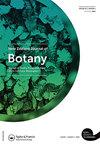鸟类对巴西紫茎腺属植物果实分散的实验研究
IF 1.4
4区 生物学
Q4 PLANT SCIENCES
引用次数: 0
摘要
【摘要】泛热带蕨属(菊科)以草本植物为主,多生长于湿润森林和溪边。它们产生大量的小果实或小穗,被腺毛覆盖,并有一个特殊的腺丘皮。果实的这些形态特征与粘附在鸟类羽毛上的分散有关,但从未经过测试。我们首次开展了一项实验研究,证明了巴西腺苷酸(Adenostemma brasilianum, Pers.)卡斯。粘在鸟的羽毛上我们进行了三个不同的实验来测试果实的粘附性和保留时间:1)单个羽毛,2)以逼真的姿势安装的鸟类标本,以及3)活的圈养鸟类。在这三个实验中,果实都能有效地附着在羽毛倒刺上,并能在一段时间内保持附着,这支持了之前的假设,即表鸟膜可能直接参与了果实分散的过程。考虑到鸟类作为果实分散剂的重要性,我们的研究结果对了解腺管膜的生物地理模式尤其重要。我们感谢R. Ramos、M. Grossi、E. Guerrero和T. bararea在野外工作中对我们的帮助,感谢P. Altieri、M. Colombo、J. Crisci和A. Jauregui对本文的批判性阅读,以及两位匿名审稿人提供的有益意见。我们也感谢K. Depot仔细修改英文写作,以及Ornitológico de Berisso博物馆的Julio Milat提供标本模型来进行实验。本研究获得了地区自然保护当局的研究许可(Res. 003/16;OPDS #17717, Dirección de Áreas Naturales Protegidas,阿根廷布宜诺斯艾利斯省),并符合执行国家的现行法律。本文是湖泊研究所“博士Raúl A. Ringuelet”(ILPLA, CCT-La Plata CONICET, UNLP)的科学贡献N°1239。作者为CONICET研究员。披露声明作者未报告潜在的利益冲突。资金部分资金支持来自国家机构Promoción Científica和Tecnológica (PICT 2017-0965和2020-1529)。本文章由计算机程序翻译,如有差异,请以英文原文为准。
The fruit dispersion of Adenostemma brasilianum (Asteraceae) by birds: an experimental approach
ABSTRACTThe pantropical genus Adenostemma (Asteraceae) includes mostly herbs which occur in wet forests and stream edges. They produce a large number of small fruits or cypselae, covered by glandular hairs and bearing a particular glandular pappus. These morphological characteristics of the fruits have been associated, but never tested, with dispersion by adhesion to birds’ feathers. We developed for the first time an experimental study to demonstrate the ability of the fruits of Adenostemma brasilianum (Pers.) Cass. to adhere to birds’ feathers. We performed three different experiments to test both the adherence and retention time of the fruits, with: 1) individual feathers, 2) taxidermied birds mounted in a life-like position, and 3) live captive birds. The fruits were effective in attaching to feather barbs under the three experiments and were able to remain attached for a period of time, supporting previous hypotheses that epiornithochory could be directly involved in the process of fruit dispersion. Our results are especially relevant in the understanding of biogeographic patterns in Adenostemma, given the importance of birds as fruit dispersion agents.KEYWORDS: Adenostemmadispersion by adhesionepiornithochoryEupatorieaepantropicalsticky fruits AcknowledgmentsWe thank R. Ramos, M. Grossi, E. Guerrero and T. Barea for helping us during field work, P. Altieri, M. Colombo, J. Crisci, and A. Jauregui for critical reading of the manuscript, and two anonymous reviewers for their helpful comments. We also thank K. Depot for carefully revising the English writing and Julio Milat from the Museo Ornitológico de Berisso for providing the taxidermied models to carry out the experiments. This study was conducted with research permits from the regional nature conservation authority (Res. 003/16; OPDS #17717, Dirección de Áreas Naturales Protegidas, Buenos Aires province, Argentina) and complies with the current laws of the country in which it was performed. This paper is the Scientific Contribution N° 1239 of the Institute of Limnology “Dr. Raúl A. Ringuelet” (ILPLA, CCT-La Plata CONICET, UNLP). Authors are CONICET Research Fellows.Disclosure statementNo potential conflict of interest was reported by the author(s).Additional informationFundingPartial financial support was received from Agencia Nacional de Promoción Científica y Tecnológica (PICT 2017–0965 and 2020–1529).
求助全文
通过发布文献求助,成功后即可免费获取论文全文。
去求助
来源期刊

New Zealand Journal of Botany
生物-植物科学
CiteScore
2.20
自引率
22.20%
发文量
27
审稿时长
>12 weeks
期刊介绍:
The New Zealand Journal of Botany publishes original research papers, review papers, perspectives, short communications, forum articles, letter and book reviews. We welcome submissions relevant to all aspects of the botany, mycology, and phycology of the South Pacific, Australia, South America, and Southern Africa. The journal’s subject matter encompasses biosystematics and biogeography, ecology, physiology, biochemistry, genetics, reproductive biology, structure and development, taxonomy, ethnobotany, palaeobotany, bryology, lichenology, mycology, plant pathology, and phycology.
 求助内容:
求助内容: 应助结果提醒方式:
应助结果提醒方式:


